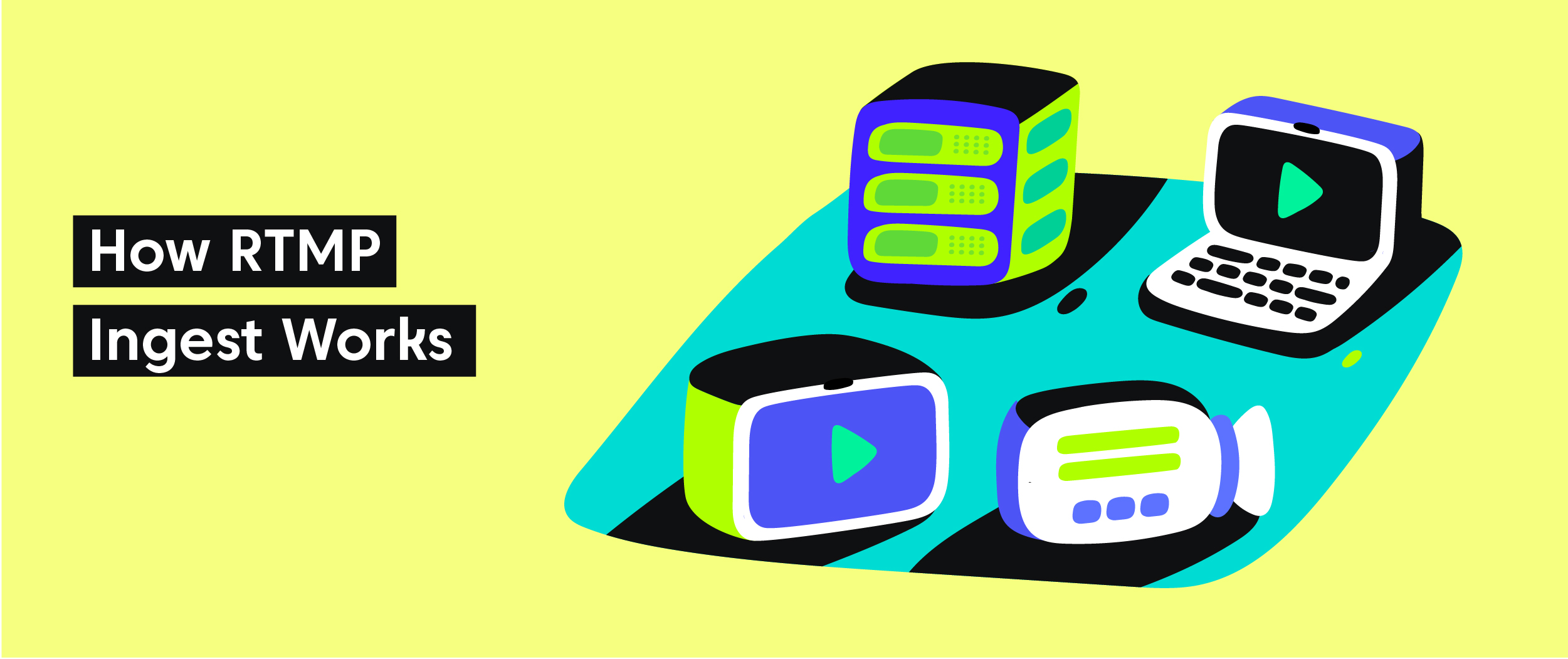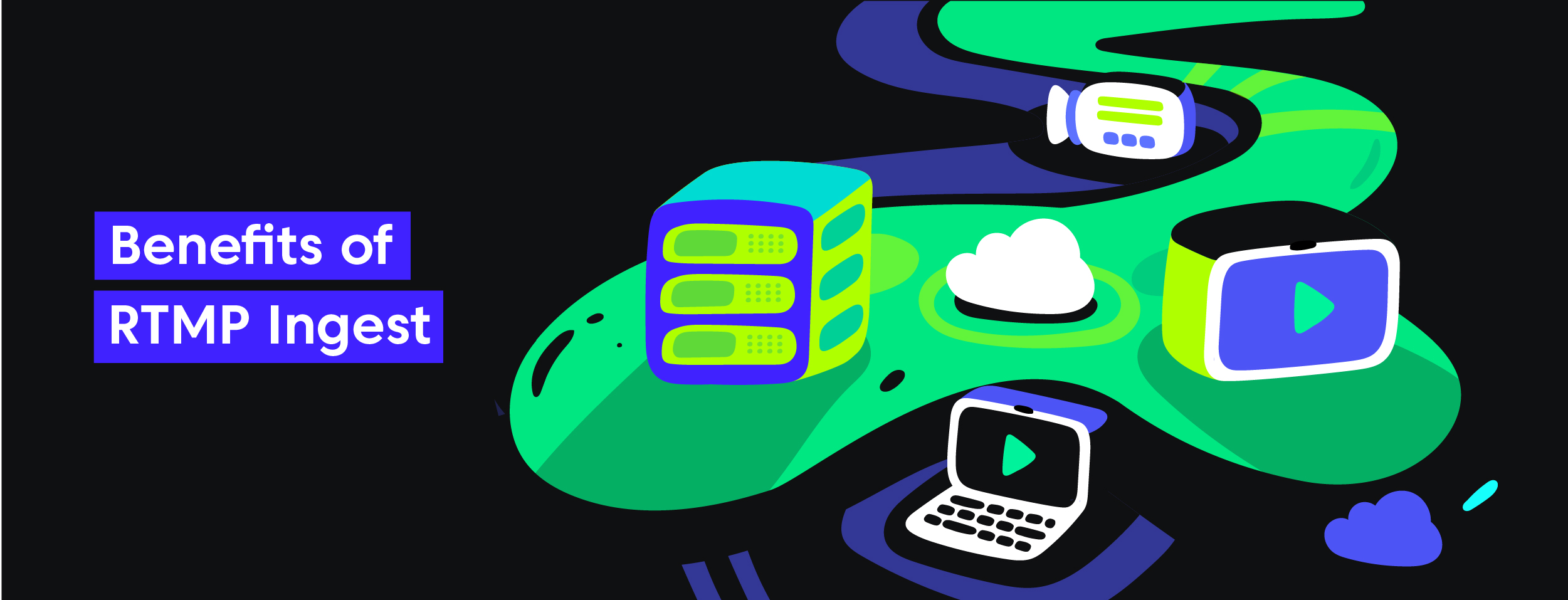If you have an interest in video streaming and mobile streaming, you’re likely aware of the challenges of keeping pace with ever-changing technology. One particular technology that has become increasingly popular in recent times is known as RTMP Ingest. This technology enables easy uploading of video content to various platforms and is widely recognized as the top choice for live streaming.
In this blog post, we will delve into the concept of RTMP Ingest, its features, and its benefits. Additionally, we’ll make comparisons between RTMP Ingest and other widely used protocols such as RTMP streaming, RTSP, and HLS streaming. Lastly, we’ll address common inquiries about RTMP Ingest and offer alternatives for those who prefer different options. So, get ready for an insightful exploration of video streaming simplification!
What is RTMP Ingest?
A method of transferring live video streams to a server using the Real-Time Messaging Protocol is known as RTMP Ingest. This involves capturing, encoding, and distributing video for low-latency streaming. This protocol is commonly used on video streaming platforms and can improve the overall viewing experience.
Why is RTMP Ingest Important for Live Streaming?
RTMP Ingest plays a crucial role in live streaming by providing a reliable and uninterrupted stream, facilitating the scaling of events, decreasing latency, and buffering issues, and allowing for interactive elements like chat and polls. It’s a key component for delivering high-quality live streaming experiences.
How RTMP Ingest Works

A method of transferring live video streams to a server for distribution through various streaming protocols is known as RTMP Ingest. This involves encoding video data and sending it over the internet. Once received by the server, it can be distributed to viewers across different platforms. RTMP Ingest is a powerful protocol that can simplify the webcasting process for broadcasters.
TCP / IP Handshake in RTMP Ingest
Establishing a secure connection between the server and the client is crucial in RTMP Ingest. The TCP/IP handshake enables this by exchanging protocol information at the beginning of the transmission. This functionality offers seamless transmission of data with minimal latency. With RTMP Ingest’s low-latency feature, content creators can deliver high-quality video content in real-time across various streaming platforms like YouTube, Facebook Live, Twitch, and Twitter while ensuring viewer engagement with interactive features such as polls and chat windows.
Steps to Connect with RTMP Ingest
Connecting with RTMP Ingest is a seamless process. It requires encoder software compatible with the RTMP protocol that can be set up to connect with the streaming server using RTMP. To start ingesting, enter the server’s URL and stream key into your encoder software. To ensure smooth ingestion, ensure that all configurations are appropriately set for stable ingestion of high-quality video content in real-time. With low latency buffering, this functionality simplifies live streaming across various platforms like YouTube, Twitch, Facebook Live, and Twitter.
Streaming with RTMP Ingest
By using “RTMP Ingest,” it is possible to stream live videos over the internet. By transferring video data from an encoder to a server via the RTMP protocol for distribution to various endpoints like social media platforms, websites, or mobile devices. High-quality streaming with low latency and minimal buffering is now achievable by connecting your encoder software that supports the RTMP protocol with a compatible server while setting up the stream key and URL of your preferred service provider.
Benefits of RTMP Ingest

Low latency and high-quality streaming make RTMP Ingest an ideal choice for live events. With the ability to adjust quality based on internet speed through adaptive bitrate streaming and easy integration with CDNs, a wider distribution of video content is possible without buffering issues. Enhance your viewers’ experience by ingesting your live stream through RTMP protocol.
RTMP Ingest vs RTMP Streaming
RTMP Ingest and RTMP Streaming are distinct processes that differ in functionality. While the former is utilized for transmitting video data from an encoder to a streaming server, the latter concerns delivering video content to end-users. Real-time delivery and low latency make RTMP Ingest highly suitable for live streaming events. However, it requires specialized software or services like YouTube or Twitch setups, which might not be optimal for all streamers or situations. Meanwhile, RTMP streaming requires stable internet speeds and adequate bandwidth for seamless playback via a video player or browser.
What makes RTMP Ingest different from RTMP?
RTMP Ingest sends video content from a source to a server, while RTMP Streaming delivers it from the server to viewers. The former enables real-time interactions and advanced features like adaptive bitrate and DVR functionality. Meanwhile, the latter only allows for one-way communication.
Using Encoder with RTMP Ingest
Using an encoder with RTMP ingest has become a popular method for sending live video content to your online audience. By taking your video source and compressing it into the RTMP protocol, you can stream it onto an RTMP server for distribution. Setting up the encoder is easy; all you need is the stream key. This technique allows real-time streaming with low latency and high-quality output that’s perfect for gaming and live events on the online streaming platform.
Using Audio with RTMP Ingest
When using audio with RTMP Ingest for live streaming purposes, you need to encode your audio into RTMP-supported codecs such as AAC, MP3, or PCM. You can optimize the bitrate of your audio to balance its quality against bandwidth usage. In addition to this balancing act between quality and efficiency, you can add advanced features like stereo sound or noise cancellation that will elevate the quality of your RTMP stream even further.
Thanks to its low-latency protocol and real-time functionalities, RTMP Ingest is ideal for applications that require a seamless experience, such as gaming or live events. With the ability to record and archive content easily thanks to RTMP ingest, you don’t have to worry about missing out on any important moments during your live stream.
Facebook Live Streaming with RTMP Ingest
Using RTMP Ingest can make streaming live videos on Facebook simpler. Ensure smooth video streaming by using a reliable RTMP encoder and optimizing your network connection to avoid buffering and other issues. Monitoring your stream’s performance through Facebook’s analytics tools is essential to ensuring that your content follows the platform’s community guidelines and copyright policies.
Twitter Live Streaming with RTMP Ingest
Twitter has emerged as a leading online video platform for live streaming video content in real-time. By leveraging the power of an RTMP ingest server, broadcasters can deliver high-quality streams with low latency to their viewers. To start streaming live on Twitter using RTMP ingest, you will need a software encoder that supports the RTMP protocol, such as OBS or Adobe Flash Media Live Encoder (FMLE).
After configuring your encoder settings to match Twitter’s recommended bitrate and resolution, you can set up your stream key and start ingesting your video source. Broadcasting live-encoded video content on Twitter has never been easier thanks to the power of RTMP ingest.
CDN with RTMP Ingest
With the RTMP Ingest protocol, one can stream live videos over the internet effortlessly. A Content Delivery Network (CDN) that supports RTMP ingests simplifies the task of delivering high-quality videos to audiences from various regions of the world. This reduces buffering issues and ensures an optimal viewing experience as it adapts to viewers’ internet speeds. Along with this feature, CDNs that support RTMP also offer analytical tools for monitoring and adjusting your video’s performance seamlessly.
An Overview of URL Structure in RTMP Ingest
The URL structure of RTMP Ingest is composed of three primary components: server address, application name, and stream name. The server address denotes where the video is being streamed from, while the application name specifies which app is used for streaming video. On the other hand, a stream name identifies a particular stream that’s being broadcasted. Having a clear understanding of these components helps ensure smooth and cost-effective live streaming with RTMP Ingest without latency or buffering issues.
Frequently Asked Questions About RTMP Ingest
RTMP Ingest is a protocol for live video streaming over the internet that enables real-time streaming and adaptive bitrate control. Using a CDN with RTMP Ingest helps simplify delivering high-quality video content worldwide while providing analytics tools for monitoring performance. Businesses and individuals need servers, encoders, and stream keys to implement RTMP Ingest. Common issues like latency and buffering can be resolved by optimizing encoder settings, reducing bitrate, or using low-latency protocols. Although RTMP Ingest relies on Flash Video Player technology, which has been discontinued, alternatives like HLS, SRT, and WebRTC are available.
How does RTMP Ingest impact the viewing experience?
RTMP Ingest can enhance the viewer’s experience by minimizing buffering and lag, providing seamless video playback, and ensuring rapid load times. Nevertheless, the internet speed and device specifications might still impact the overall viewing experience, so it’s essential to use a high-quality RTMP server for optimal results.
HLS Streaming & How it Relates to RTMP Ingest
The popular HTTP Live Streaming (HLS) protocol divides video content into smaller chunks and sends each chunk over HTTP to offer live and on-demand video content over the internet. This results in faster load times and smoother playback as the video player shifts between different quality levels based on available bandwidth. Combining HLS streaming with RTMP ingest enhances streaming’s reliability and scalability.
HLS or RTMP: Which Streaming Protocol Should Broadcasters Choose?
When deciding between HLS and RTMP for streaming, broadcasters should consider their specific needs and goals. While HLS offers wider support and adaptability for VOD, RTMP has lower latency and allows real-time interaction with viewers, making it ideal for live streaming.
RTMP vs. RTSP: Which is Better?
When it comes to video streaming, RTMP and RTSP are two streaming protocols with different strengths. RTMP is ideal for live streaming and mobile devices, while RTSP is better suited for on-demand playback. Ultimately, the decision depends on your specific requirements.
RTMP Alternatives for Ingest
The use of live streaming has increased in recent years due to the popularity of social media platforms. RTMP Ingest has been widely used, but there are alternatives available that are worth considering. HTTP Live Streaming (HLS) adapts to varying network conditions, providing high-quality video content, making it ideal for VOD scenarios. Additionally, WebRTC can be used for low-latency streaming, while SRT provides secure transport of video streams. MPEG-DASH enables adaptive bitrate streaming, enhancing the user experience.
Conclusion
RTMP Ingest presents an upcoming solution for streaming videos. It presents a reliable and efficient method for transmitting live streams, enabling real-time engagement with your viewers. RTMP Ingest guarantees the delivery of superior video and audio quality without any buffering or low latency. Moreover, it extends compatibility to various devices, platforms, and protocols. If you desire to improve your live streaming experience, take into account the utilization of RTMP Ingest.
Frequently Asked Questions
What is the RTMP Ingest Point?
The RTMP ingest point is where a video stream enters a streaming server and gets ready for distribution. It comes with a unique URL and stream key that must be configured on the encoder, and popular options include Wowza, Livestream, DaCast, and Castr.
What is Ingest in Streaming?
Ingest is the process of uploading and optimizing video content for delivery on a live streaming platform. It involves converting the video format and using other streaming protocols like RTMP. Efficient ingest procedures are crucial for delivering high-quality streaming experiences.
What is an RTMP Feed?
An RTMP feed is a live video stream transmitted via the Real-Time Messaging Protocol. It’s used for real-time broadcasting, webinars, and events. However, to receive and distribute the video stream, an RTMP server is required.
What is RTMP Ingest, and what are its advantages over other delivery methods such as email or SMS?
RTMP Ingest is a streaming protocol that offers low latency, high-quality video, and secure delivery. It is designed for multimedia content and provides better efficiency compared to email or SMS. Content creators can reach a larger audience and deliver an enhanced user experience with RTMP Ingest.
What is Stream Key?
A unique code known as a “stream key” enables streaming software to establish a connection with a streaming platform and transmit your video content for live streaming. Each platform has its own exclusive stream key, requiring the discovery of this key in your account settings to link your preferred software with the online video platform of your choice. Stream keys usually consist of alphanumeric characters and range from 16 to 32 characters in length. They are sensitive to letter cases and should be kept confidential, as disclosure of your stream key would grant access to your live stream by anyone in possession of it.






